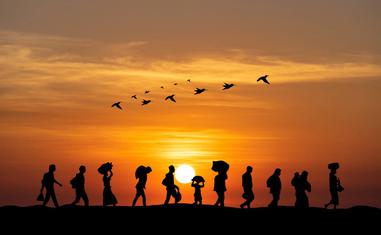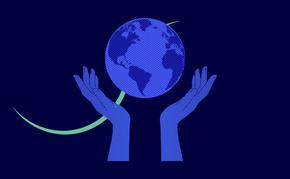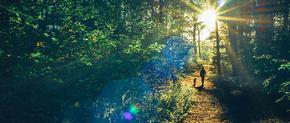The views expressed in our content reflect individual perspectives and do not represent the authoritative views of the Baha'i Faith.
When we think of humanity, we can certainly envision an endless stream, a flow of relations stretching from the past to the present.
Human movement, though having infinite iterations, is most well-known by the act of walking. Ancient tribes walked across various straits from one continent to the next, others wandered in vast deserts looking for signs in the heavens or for paradise on Earth, or simply for water. Still others walked to escape various forms of oppression, either natural or manmade … and it yet continues.
RELATED: What Do Religions Have to Say about Refugees and Migration?
The enormity of migration has also become one of the sources for humanity’s expanding consciousness. In 2005, The Universal House of Justice of the Baha’i Faith wrote:
Millions of refugees fleeing from persecution have swept like tidal waves back and forth across the European, African and Asiatic continents, particularly. Amid the suffering such turmoil has caused, one perceives the progressive integration of the world’s races and cultures as the citizenry of a single global homeland. As a result, people of every background have been exposed to cultures and norms of others about whom their forefathers knew little or nothing, exciting a search for meaning that cannot be evaded.
Since then, the phenomenon of global homelessness has only increased. The “refugee state” that now effects hundreds of millions of people, moves me to speak to the courage and the faith of people, as they attempt to find some peace, some shelter somewhere, to regroup from lives shattered by oppressive conditions.
In addition, those whose ancestors were captured and enslaved, those whose native cultures were purposefully decimated and “relocated,” those who managed to survive mass genocides, those who’ve sought asylum from various forms of tyranny, have all occupied my ruminations on existential homelessness. As we witness this particular alienation, its suffering resonates. We recognize a deeper connection, one not based on nationality nor any of the temporal distinctions.
In essence we are all simply, human beings, living on this sphere together, spinning around a sun, amidst infinite galaxies. In this sense, everyone is kin. Baha’u’llah put it this way in the late 1800s, “The earth is but one country, and mankind its citizens.”
It is from these thoughts that WAYFARER project emerged. To convert these ideas to art, I have used the image of the foot and shoe print. To print one’s being on the earth is literally a stamp of existence, “I was here.” Footprints are also a record of human striving.
In these two works, The Border and The Pilgrimage, the footprints were made with participation of the art students of the Rowlett Middle Academy in Bradenton, Florida. It is a public charter school dedicated to diversity and leadership in the arts. These young “actors” helped me create the narratives I sought by lending their feet, their strides to make footprints. In a sense they’ve acted as surrogates for others who are actually out there on very difficult paths.
RELATED: Baha’is and Immigration: How to Build a World Without Borders
The project created the opportunity to involve the students in thinking about the conditions that form the trajectories of life, as well as to experience that art can be made of anything. Other prints were made with soles of shoes from many cast-offs, that I have been collecting.
The other visual component in the project is the format. The “pathways” are made of long strips of translucent material. The finished works are made by layering the strips which have been painted by feet walking their lengths.
In this composite-based technique, there are hundreds of footprints assembled together. This density evokes a gathering together, but there is autonomy and diversity at the same time, as each footprint is unique, and each person’s stride is different.
The layering effect follows the process and operations of the abstract works I make using marks or stripes as images. I simply supplanted those shapes with prints from human feet. Through this change, the works speak to a more social aspect of humanity.
The pathways all start mounted to the ground and then lift in arcs ascending upwards towards the sky. This structure imitates the arc of the human journey, of our evolution, from animal to spiritual, from ignorance to knowledge. It is the way of aspiration.
The Border is about compression. I chose to use only footprints in this one, to elicit vulnerability in the content. The earth tones reflect an archetypal humanity. They start out on the pathway in a casual manner but as they climb upward the path gets more crowded. The formal language of the increasing compression expresses the human and political condition. At the very top, people are jammed up at a border they cannot cross. Red tape holds them back from going into a promised land.
This piece represents the struggle for existence.
In The Pilgrimage, the opposite happens. A kind of celebratory atmosphere pervades the procession of brightly colored foot and shoe prints. Having asked quite a few people what they thought about the goal of pilgrimage, there were so many different answers that finding one image to encompass them all was seemingly impossible.
Several people said, “it’s not about the goal, it’s about the journey.” I remembered this nuanced notion of pilgrimage from the spiritual readings of my youth. I realized that it was not whether one attains through the journey, or at the threshold of one’s Beloved, but that in either case, one dissolves. One’s ego dissolves in reunion with the Beloved, however, whenever, it takes place. So I found a way to dissolve the prints as they ascended toward the top of the pathway. That these two works run side by side is intended, as I felt they have great complementarity. One is concerned with physical well-being, the other with the spiritual. One is struggle, the other is searching. One applies to worldly conditions, the other to conditions within the heart. I don’t offer them here as choices, as the old either/or scenario, but rather as a whole.
Both paths are running within us, simultaneously.
This Wayfarer Project is related to my previous project, Kristallnacht, in which I used shards of broken glass to make images that gave the visual sensation of broken barriers of various kinds. Both projects explore my ongoing interest in an aesthetic that works with the infusion of light in mater. In the Wayfarer Project the visual evidence of the human footprint indicates beings moving towards the endlessly evolving horizon of possibilities, searching for a better, more harmonious state of being, a state of peace and safety and love. It’s about one of the most profound images I can think of.

















Comments
Sign in or create an account
Continue with Facebookor